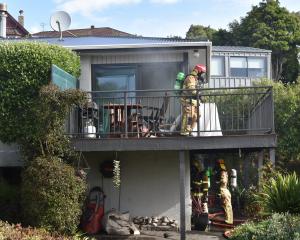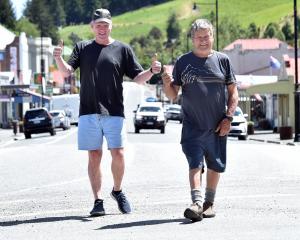The engine from a Royal New Zealand Air Force Harvard that crashed in Mt Aspiring National Park 60 years ago, killing one of the two men on board, has been discovered.

It was found last Friday by Ben Lund (33), of Palmerston North, who was fossicking for gold in the rugged creek below the point where it emerges from frozen ice and snow.
Mr Lund said it was ''bizarre'' the engine had not been found before.
''It's mind-boggling that it is so close to the hut but it shows you that if you drop off the track, you're in no man's land.''
Mr Lund thought at first the engine was from a helicopter.
However, a better description of the engine was relayed by the Otago Daily Times to Wanaka aviation identity Sir Tim Wallis, who quickly connected it with stories he had heard in his childhood of a crashed Harvard.
According to ODT files, a Harvard left the Taieri aerodrome at 6am on Monday, January 17, 1953, to search for two missing Wellington trampers.
The pilot was Flight Lieutenant Aubrey Bills and the co-pilot Squadron Leader George Johnson (39), of Wallace St, Dunedin.
The ODT reported that by 8am the plane had crashed on the western side of Mt Aspiring at about 4500ft (1371m).
Sqn Ldr Johnson was badly injured and Fl Lt Bills - who had a gashed leg and was suffering from shock - made him comfortable and headed down to Aspiring Hut, where a search party looking for the trampers was stationed.
''When Fl Lt Bills staggered into their view, shots were fired to recall members of the party scouring the mountain faces,'' the ODT reported.
By the time the search party reached Sqn Ldr Johnson, about 5pm, he had died.
It was thought the plane might have been caught by a strong air current while turning and had been ''swatted against the rocky mountainside''.
Sqn Ldr Johnson was a mountaineer and had only recently taken over command of No 4 Territorial Air Force Squadron. He had been a war-time pilot with the RNZAF and was a teacher at the King Edward Technical College in Dunedin.
He was survived by his wife and three children.
The engine found last week is corroded and worn, but Mr Lund hoped to see it lifted off the mountain and displayed in a museum. He believed it might have been frozen inside a glacier for some time, slowly making its way down the mountain.
No other aircraft parts could be seen nearby.
Mr Lund contacted the police as soon as he found the engine and the ODT informed the Air Force of the find on Wednesday. Air Force Museum of New Zealand research officer Simon Moody said, when contacted, the engine appeared to be a Pratt and Whitney Wasp, in keeping with a Harvard trainer aircraft. In terms of its alloy parts, the engine seemed ''in pretty good condition''.
Mr Moody said the museum was not in a position to effect a recovery of the engine, but ''if it was recovered by another party, would certainly accept it if offered for donation''.
• The missing trampers, Frank Siddle and Charles Foskett, were 12 days overdue when the plane crash was reported, and little hope was held for their rescue. Searchers found their bodies in a crevasse near Tyndall Ridge on January 23, 1953.












